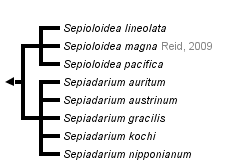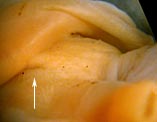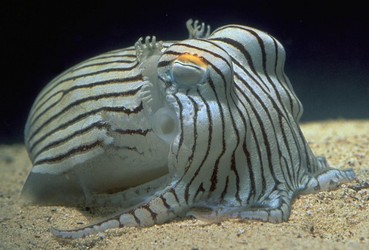Sepiadariidae
Richard E. Young


This tree diagram shows the relationships between several groups of organisms.
The root of the current tree connects the organisms featured in this tree to their containing group and the rest of the Tree of Life. The basal branching point in the tree represents the ancestor of the other groups in the tree. This ancestor diversified over time into several descendent subgroups, which are represented as internal nodes and terminal taxa to the right.

You can click on the root to travel down the Tree of Life all the way to the root of all Life, and you can click on the names of descendent subgroups to travel up the Tree of Life all the way to individual species.
For more information on ToL tree formatting, please see Interpreting the Tree or Classification. To learn more about phylogenetic trees, please visit our Phylogenetic Biology pages.
close boxIntroduction
Species of the Sepiadariidae are short (2 - 4 cm ML), broad cephalopods with a rounded posterior mantle. They are benthic, may have striking fixed color patterns, and inhabit shallow waters of tropical and subtropical seas of the Indo-West Pacific.
Brief diagnosis:
A Sepiolida ...
- with funnel locking-apparatus fused or with two depressions.
Characteristics
- Arms
- Left arm IV hectocotylized.
- Left arm IV hectocotylized.
- Head
- Beaks: Descriptions can be found here: Lower beak; upper beak.
- Beaks: Descriptions can be found here: Lower beak; upper beak.
- Funnel
- Funnel locking-apparatus with two depressions (Sepioloidea) or fused (Sepiadarium).
 Click on an image to view larger version & data in a new window
Click on an image to view larger version & data in a new window

Figure. Left - Ventral view of the funnel locking-apparatus of Sepioloidea pacifica, 12 mm ML, 43°S, 167°E. Right - Ventral view of the funnel base with the mantle reflected backward showing the strong fusion of the funnel locking-apparatus (arrow) of Sepiadarium sp. Photographs by R. Young.
- Funnel locking-apparatus with two depressions (Sepioloidea) or fused (Sepiadarium).
- Mantle
- Dorsal margin fused to head.
- Dorsal margin fused to head.
- Shell
- Shell absent.
Nomenclature
A list of all nominal genera and species in the Sepiadariidae can be found here. The list includes the current status and type species of all genera, and the current status, type repository and type locality of all species and all pertinent references.
References
Lu, C. C., A. Guerra, F. Palumbo and W. C. Summers. 1992. Order Sepioidea Naef, 1916. In: Sweeney, M. J., C. F. E. Roper, K. M. Mangold, M. R. Clarke and S. V. Boletzky (eds.). "Larval" and juvenile cephalopods: a manual for their identification. Smithson. Contr. Zool. No. 513: 1-282.
About This Page

University of Hawaii, Honolulu, HI, USA
Page copyright © 2019
 Page: Tree of Life
Sepiadariidae .
Authored by
Richard E. Young.
The TEXT of this page is licensed under the
Creative Commons Attribution-NonCommercial License - Version 3.0. Note that images and other media
featured on this page are each governed by their own license, and they may or may not be available
for reuse. Click on an image or a media link to access the media data window, which provides the
relevant licensing information. For the general terms and conditions of ToL material reuse and
redistribution, please see the Tree of Life Copyright
Policies.
Page: Tree of Life
Sepiadariidae .
Authored by
Richard E. Young.
The TEXT of this page is licensed under the
Creative Commons Attribution-NonCommercial License - Version 3.0. Note that images and other media
featured on this page are each governed by their own license, and they may or may not be available
for reuse. Click on an image or a media link to access the media data window, which provides the
relevant licensing information. For the general terms and conditions of ToL material reuse and
redistribution, please see the Tree of Life Copyright
Policies.
- Content changed 15 August 2010
Citing this page:
Young, Richard E. 2010. Sepiadariidae . Version 15 August 2010 (under construction). http://tolweb.org/Sepiadariidae/19986/2010.08.15 in The Tree of Life Web Project, http://tolweb.org/









 Go to quick links
Go to quick search
Go to navigation for this section of the ToL site
Go to detailed links for the ToL site
Go to quick links
Go to quick search
Go to navigation for this section of the ToL site
Go to detailed links for the ToL site